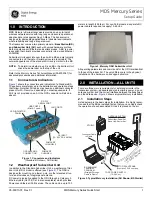
NPX136D Series Panel Mount P25 VHF Transceiver
SM68 Installation and Operation Manual
Section 2 Rev: 1.00
Issue
4 Page
2-2
ENG-FORM: 805-0118.DOT
CONFIDENTIAL AND PROPRIETARY TO NORTHERN AIRBORNE TECHNOLOGY LTD.
2.4.1
Note on Cable Routing
Do not bundle any lines from this unit with
transmitter coax lines
. Do not bundle any logic, audio, or DC
power lines from this unit with 400 Hz synchro wiring or AC power lines. Do not position this unit next to
any device
with a strong alternating magnetic field such as an inverter or significant interference
to operation will result.
In all installations, use shielded cable
exactly as shown and ground as
indicated
. Significant problems may result if these guidelines are not followed.
2.4.2
Notes on Cable Wiring and Shielding
All audio installations can be severely degraded by incorrect wiring and shielding, and may result in much
higher cross-talk, hum, and ground-loop interference. This should be considered when audio wiring to
and from the radio installation is performed.
2.4.3
Notes on Grounding
The case of the radio must be electrically grounded for maximum resistance to low frequency
interference. A pin on the connector (Chassis ground) is provided and must be connected by a short wire
to a clean ground, NOT jumpered to the power ground wire connection.
Refer to the aircraft structural repair manual and maintenance manual for instructions and information
pertinent to this installation.
2.4.4
Cabling and Wiring
All wire shall be selected in accordance with the original aircraft manufacturer's Maintenance Instructions
or AC43.13-1B Change 1, Paragraphs 11-76 through 11-78. Unshielded wire types shall qualify to
MIL-W-22759 as specified in AC43.13-1B Change 1, Paragraphs 11-85, 11-86, and listed in Table 11-11.
For shielded wire applications, use Tefzel MIL-C-27500 shielded wire with solder sleeves (for shield
terminations) to make the most compact and easily terminated interconnect. Follow the connector map in
Section 2.6 as required.
Coaxial cable shall be selected in accordance with MIL-C-17 unless otherwise specified. Do not use coax
cable with PVC insulation. Teflon dielectric cable is encouraged at or above VHF frequencies or where
cable runs exceed 8 feet. Note that at VHF frequencies, cables losses due to long cable runs and tight
bends may reduce the ERP (Effective Radiated Power) by greater than 50%.
Allow 3" from the end of the shielded wiring to the shield termination to allow the connector hood to be
easily installed. Reference the interconnect drawing in Section 2.6 for shield termination details. Note that
the hood is a "clamshell" hood, and is installed after the wiring is complete. Installation cabling must allow
the radio to be easily withdrawn for disconnection and field service adjustments. Ensure an adequate
service loop in the routing of the cables. It can be a serious issue if the unit is installed with the cables so
short that the unit cannot be removed without disassembly of the surrounding structures. At least 30 cm
(1 foot) of free cable is recommended.
Maintain wire segregation and route wiring in accordance with the original aircraft manufacturers
Maintenance Instructions. Fabrication & installation of wiring harness should be in accordance with the
original aircraft manufacturer’s Maintenance Instructions or AC 43.13-1B Change 1, chapter 11, sections 5
to 13, 16 and 17. Coaxial cables shall be routed separately from existing wire bundles in the aircraft to
minimize electromagnetic coupling effects. To prevent RF interference between similar systems, it is












































